Financial Resources and Decisions for Clariton Antique Ltd: Report
VerifiedAdded on 2020/01/28
|21
|5990
|41
Report
AI Summary
This report provides a comprehensive analysis of financial resources and decisions, focusing on Clariton Antique Ltd. It begins by identifying and explaining various sources of finance, including share capital, debentures, and bank loans, and discusses their implications for the company. The report then delves into the analysis of the cost of finance, emphasizing the importance of financial planning and the assessment of information needs for different decision-makers. Furthermore, it explores the impact of finance on financial statements, analyzing them to make informed decisions and calculating unit costs for effective project evaluation. The report concludes with a discussion of monetary declarations, comparing financial statement formats and interpreting their implications for the company's financial health and future prospects.
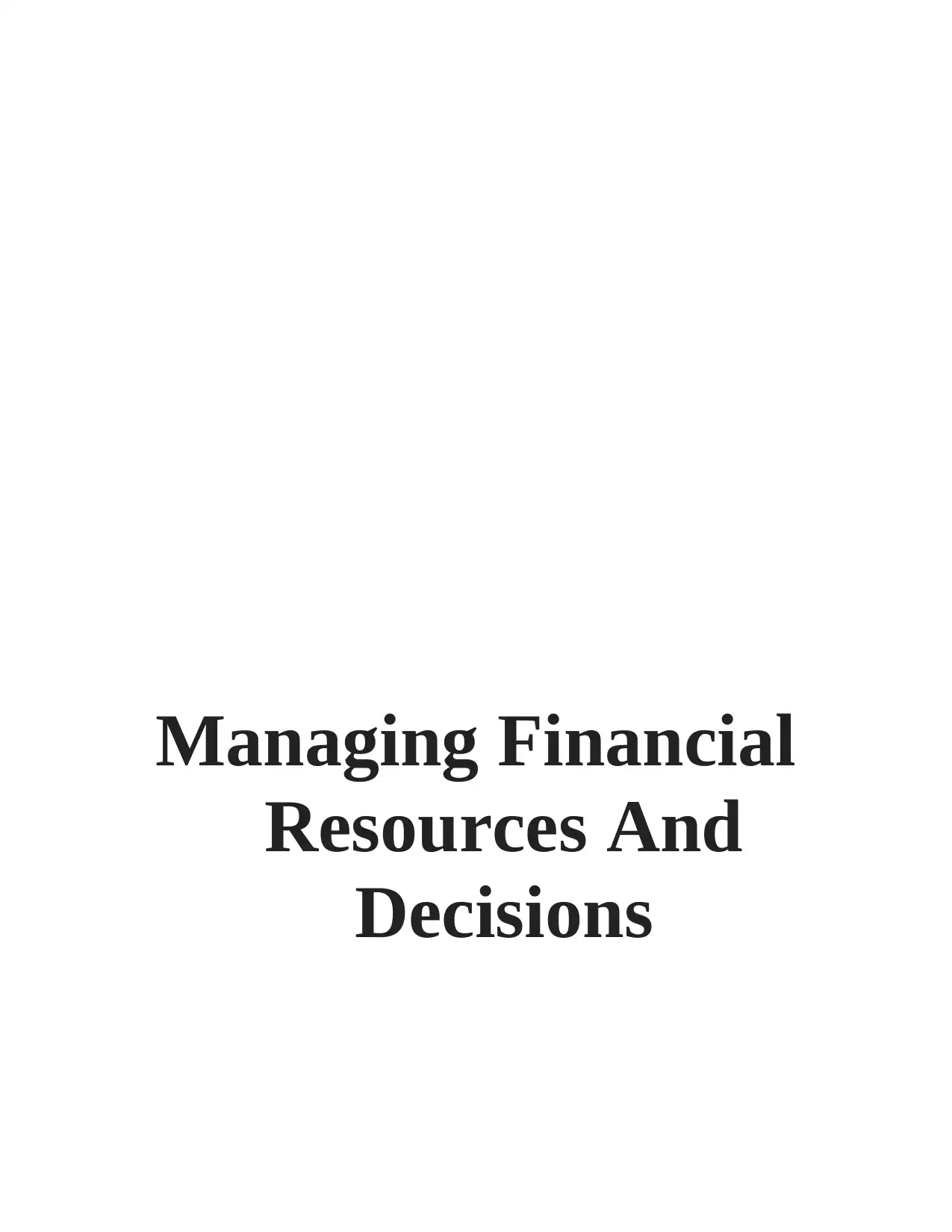
Managing Financial
Resources And
Decisions
Resources And
Decisions
Paraphrase This Document
Need a fresh take? Get an instant paraphrase of this document with our AI Paraphraser
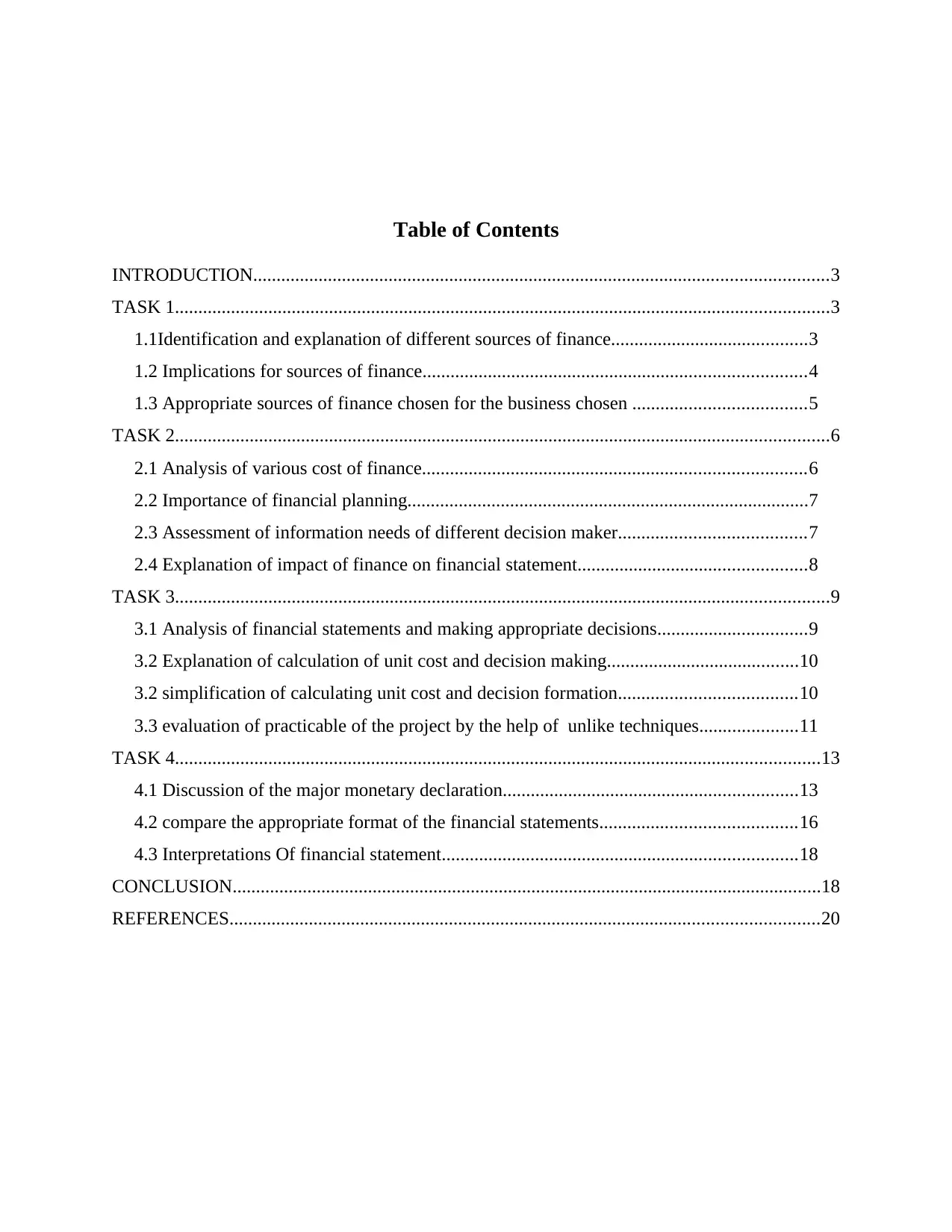
Table of Contents
INTRODUCTION...........................................................................................................................3
TASK 1............................................................................................................................................3
1.1Identification and explanation of different sources of finance..........................................3
1.2 Implications for sources of finance..................................................................................4
1.3 Appropriate sources of finance chosen for the business chosen .....................................5
TASK 2............................................................................................................................................6
2.1 Analysis of various cost of finance..................................................................................6
2.2 Importance of financial planning......................................................................................7
2.3 Assessment of information needs of different decision maker........................................7
2.4 Explanation of impact of finance on financial statement.................................................8
TASK 3............................................................................................................................................9
3.1 Analysis of financial statements and making appropriate decisions................................9
3.2 Explanation of calculation of unit cost and decision making.........................................10
3.2 simplification of calculating unit cost and decision formation......................................10
3.3 evaluation of practicable of the project by the help of unlike techniques.....................11
TASK 4..........................................................................................................................................13
4.1 Discussion of the major monetary declaration...............................................................13
4.2 compare the appropriate format of the financial statements..........................................16
4.3 Interpretations Of financial statement............................................................................18
CONCLUSION..............................................................................................................................18
REFERENCES..............................................................................................................................20
INTRODUCTION...........................................................................................................................3
TASK 1............................................................................................................................................3
1.1Identification and explanation of different sources of finance..........................................3
1.2 Implications for sources of finance..................................................................................4
1.3 Appropriate sources of finance chosen for the business chosen .....................................5
TASK 2............................................................................................................................................6
2.1 Analysis of various cost of finance..................................................................................6
2.2 Importance of financial planning......................................................................................7
2.3 Assessment of information needs of different decision maker........................................7
2.4 Explanation of impact of finance on financial statement.................................................8
TASK 3............................................................................................................................................9
3.1 Analysis of financial statements and making appropriate decisions................................9
3.2 Explanation of calculation of unit cost and decision making.........................................10
3.2 simplification of calculating unit cost and decision formation......................................10
3.3 evaluation of practicable of the project by the help of unlike techniques.....................11
TASK 4..........................................................................................................................................13
4.1 Discussion of the major monetary declaration...............................................................13
4.2 compare the appropriate format of the financial statements..........................................16
4.3 Interpretations Of financial statement............................................................................18
CONCLUSION..............................................................................................................................18
REFERENCES..............................................................................................................................20
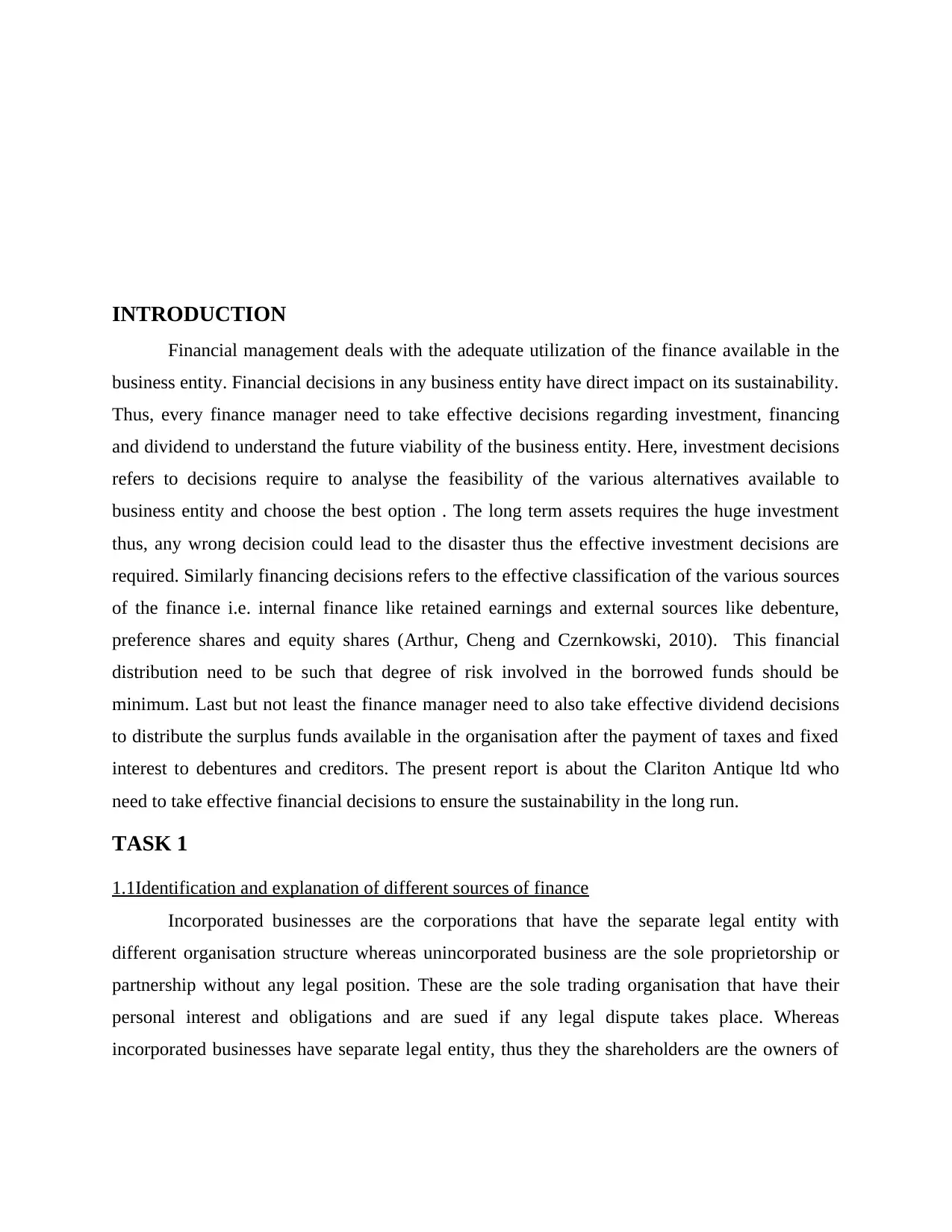
INTRODUCTION
Financial management deals with the adequate utilization of the finance available in the
business entity. Financial decisions in any business entity have direct impact on its sustainability.
Thus, every finance manager need to take effective decisions regarding investment, financing
and dividend to understand the future viability of the business entity. Here, investment decisions
refers to decisions require to analyse the feasibility of the various alternatives available to
business entity and choose the best option . The long term assets requires the huge investment
thus, any wrong decision could lead to the disaster thus the effective investment decisions are
required. Similarly financing decisions refers to the effective classification of the various sources
of the finance i.e. internal finance like retained earnings and external sources like debenture,
preference shares and equity shares (Arthur, Cheng and Czernkowski, 2010). This financial
distribution need to be such that degree of risk involved in the borrowed funds should be
minimum. Last but not least the finance manager need to also take effective dividend decisions
to distribute the surplus funds available in the organisation after the payment of taxes and fixed
interest to debentures and creditors. The present report is about the Clariton Antique ltd who
need to take effective financial decisions to ensure the sustainability in the long run.
TASK 1
1.1Identification and explanation of different sources of finance
Incorporated businesses are the corporations that have the separate legal entity with
different organisation structure whereas unincorporated business are the sole proprietorship or
partnership without any legal position. These are the sole trading organisation that have their
personal interest and obligations and are sued if any legal dispute takes place. Whereas
incorporated businesses have separate legal entity, thus they the shareholders are the owners of
Financial management deals with the adequate utilization of the finance available in the
business entity. Financial decisions in any business entity have direct impact on its sustainability.
Thus, every finance manager need to take effective decisions regarding investment, financing
and dividend to understand the future viability of the business entity. Here, investment decisions
refers to decisions require to analyse the feasibility of the various alternatives available to
business entity and choose the best option . The long term assets requires the huge investment
thus, any wrong decision could lead to the disaster thus the effective investment decisions are
required. Similarly financing decisions refers to the effective classification of the various sources
of the finance i.e. internal finance like retained earnings and external sources like debenture,
preference shares and equity shares (Arthur, Cheng and Czernkowski, 2010). This financial
distribution need to be such that degree of risk involved in the borrowed funds should be
minimum. Last but not least the finance manager need to also take effective dividend decisions
to distribute the surplus funds available in the organisation after the payment of taxes and fixed
interest to debentures and creditors. The present report is about the Clariton Antique ltd who
need to take effective financial decisions to ensure the sustainability in the long run.
TASK 1
1.1Identification and explanation of different sources of finance
Incorporated businesses are the corporations that have the separate legal entity with
different organisation structure whereas unincorporated business are the sole proprietorship or
partnership without any legal position. These are the sole trading organisation that have their
personal interest and obligations and are sued if any legal dispute takes place. Whereas
incorporated businesses have separate legal entity, thus they the shareholders are the owners of
⊘ This is a preview!⊘
Do you want full access?
Subscribe today to unlock all pages.

Trusted by 1+ million students worldwide
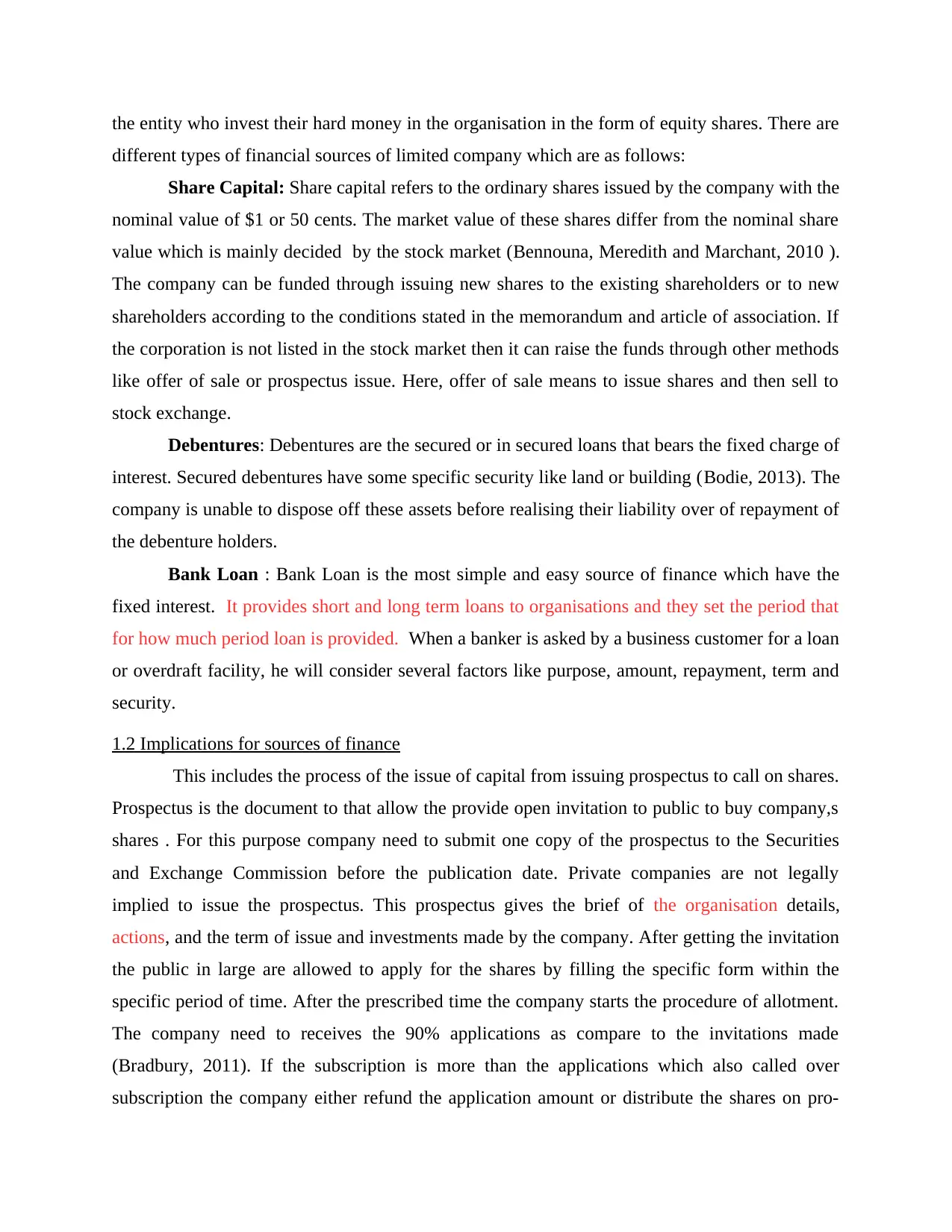
the entity who invest their hard money in the organisation in the form of equity shares. There are
different types of financial sources of limited company which are as follows:
Share Capital: Share capital refers to the ordinary shares issued by the company with the
nominal value of $1 or 50 cents. The market value of these shares differ from the nominal share
value which is mainly decided by the stock market (Bennouna, Meredith and Marchant, 2010 ).
The company can be funded through issuing new shares to the existing shareholders or to new
shareholders according to the conditions stated in the memorandum and article of association. If
the corporation is not listed in the stock market then it can raise the funds through other methods
like offer of sale or prospectus issue. Here, offer of sale means to issue shares and then sell to
stock exchange.
Debentures: Debentures are the secured or in secured loans that bears the fixed charge of
interest. Secured debentures have some specific security like land or building (Bodie, 2013). The
company is unable to dispose off these assets before realising their liability over of repayment of
the debenture holders.
Bank Loan : Bank Loan is the most simple and easy source of finance which have the
fixed interest. It provides short and long term loans to organisations and they set the period that
for how much period loan is provided. When a banker is asked by a business customer for a loan
or overdraft facility, he will consider several factors like purpose, amount, repayment, term and
security.
1.2 Implications for sources of finance
This includes the process of the issue of capital from issuing prospectus to call on shares.
Prospectus is the document to that allow the provide open invitation to public to buy company,s
shares . For this purpose company need to submit one copy of the prospectus to the Securities
and Exchange Commission before the publication date. Private companies are not legally
implied to issue the prospectus. This prospectus gives the brief of the organisation details,
actions, and the term of issue and investments made by the company. After getting the invitation
the public in large are allowed to apply for the shares by filling the specific form within the
specific period of time. After the prescribed time the company starts the procedure of allotment.
The company need to receives the 90% applications as compare to the invitations made
(Bradbury, 2011). If the subscription is more than the applications which also called over
subscription the company either refund the application amount or distribute the shares on pro-
different types of financial sources of limited company which are as follows:
Share Capital: Share capital refers to the ordinary shares issued by the company with the
nominal value of $1 or 50 cents. The market value of these shares differ from the nominal share
value which is mainly decided by the stock market (Bennouna, Meredith and Marchant, 2010 ).
The company can be funded through issuing new shares to the existing shareholders or to new
shareholders according to the conditions stated in the memorandum and article of association. If
the corporation is not listed in the stock market then it can raise the funds through other methods
like offer of sale or prospectus issue. Here, offer of sale means to issue shares and then sell to
stock exchange.
Debentures: Debentures are the secured or in secured loans that bears the fixed charge of
interest. Secured debentures have some specific security like land or building (Bodie, 2013). The
company is unable to dispose off these assets before realising their liability over of repayment of
the debenture holders.
Bank Loan : Bank Loan is the most simple and easy source of finance which have the
fixed interest. It provides short and long term loans to organisations and they set the period that
for how much period loan is provided. When a banker is asked by a business customer for a loan
or overdraft facility, he will consider several factors like purpose, amount, repayment, term and
security.
1.2 Implications for sources of finance
This includes the process of the issue of capital from issuing prospectus to call on shares.
Prospectus is the document to that allow the provide open invitation to public to buy company,s
shares . For this purpose company need to submit one copy of the prospectus to the Securities
and Exchange Commission before the publication date. Private companies are not legally
implied to issue the prospectus. This prospectus gives the brief of the organisation details,
actions, and the term of issue and investments made by the company. After getting the invitation
the public in large are allowed to apply for the shares by filling the specific form within the
specific period of time. After the prescribed time the company starts the procedure of allotment.
The company need to receives the 90% applications as compare to the invitations made
(Bradbury, 2011). If the subscription is more than the applications which also called over
subscription the company either refund the application amount or distribute the shares on pro-
Paraphrase This Document
Need a fresh take? Get an instant paraphrase of this document with our AI Paraphraser
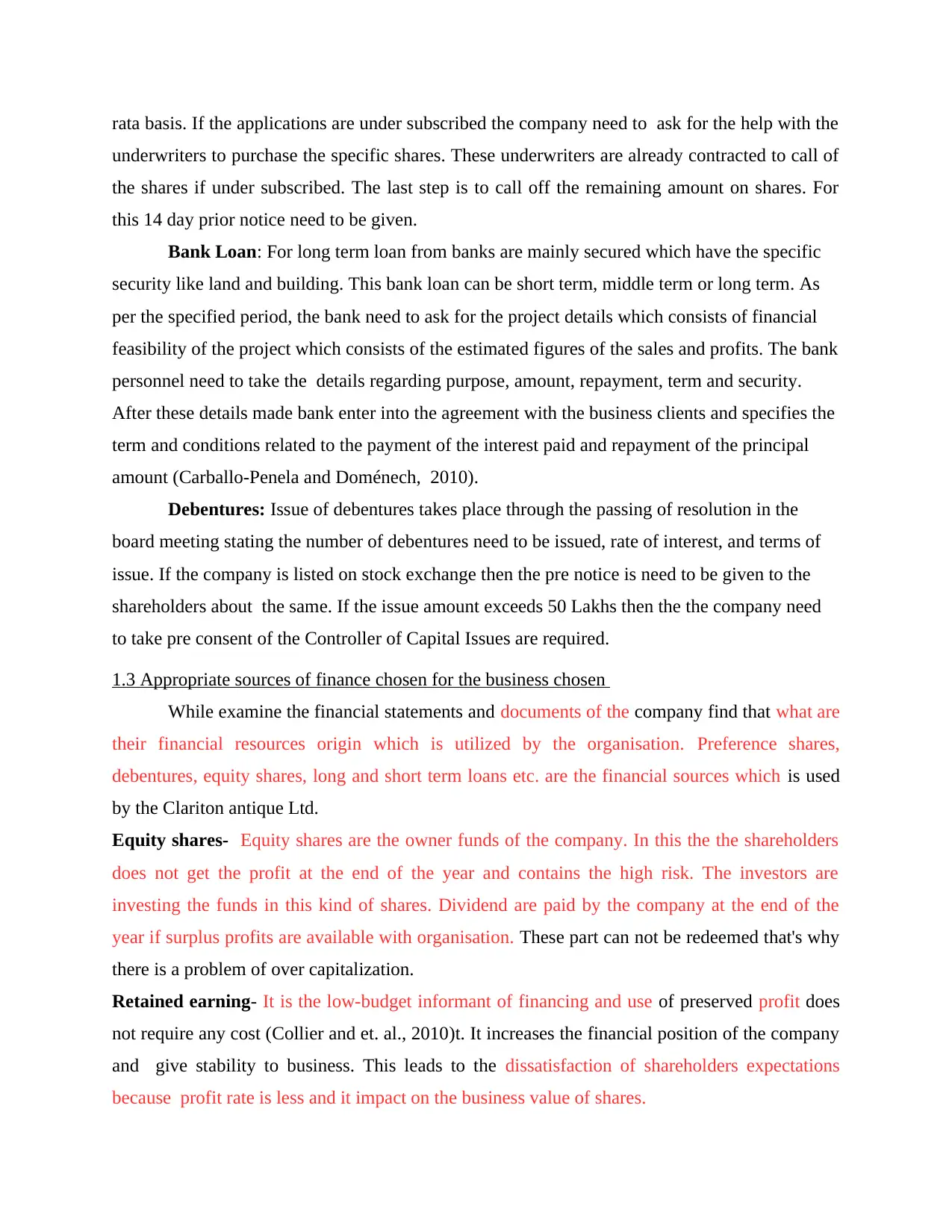
rata basis. If the applications are under subscribed the company need to ask for the help with the
underwriters to purchase the specific shares. These underwriters are already contracted to call of
the shares if under subscribed. The last step is to call off the remaining amount on shares. For
this 14 day prior notice need to be given.
Bank Loan: For long term loan from banks are mainly secured which have the specific
security like land and building. This bank loan can be short term, middle term or long term. As
per the specified period, the bank need to ask for the project details which consists of financial
feasibility of the project which consists of the estimated figures of the sales and profits. The bank
personnel need to take the details regarding purpose, amount, repayment, term and security.
After these details made bank enter into the agreement with the business clients and specifies the
term and conditions related to the payment of the interest paid and repayment of the principal
amount (Carballo-Penela and Doménech, 2010).
Debentures: Issue of debentures takes place through the passing of resolution in the
board meeting stating the number of debentures need to be issued, rate of interest, and terms of
issue. If the company is listed on stock exchange then the pre notice is need to be given to the
shareholders about the same. If the issue amount exceeds 50 Lakhs then the the company need
to take pre consent of the Controller of Capital Issues are required.
1.3 Appropriate sources of finance chosen for the business chosen
While examine the financial statements and documents of the company find that what are
their financial resources origin which is utilized by the organisation. Preference shares,
debentures, equity shares, long and short term loans etc. are the financial sources which is used
by the Clariton antique Ltd.
Equity shares- Equity shares are the owner funds of the company. In this the the shareholders
does not get the profit at the end of the year and contains the high risk. The investors are
investing the funds in this kind of shares. Dividend are paid by the company at the end of the
year if surplus profits are available with organisation. These part can not be redeemed that's why
there is a problem of over capitalization.
Retained earning- It is the low-budget informant of financing and use of preserved profit does
not require any cost (Collier and et. al., 2010)t. It increases the financial position of the company
and give stability to business. This leads to the dissatisfaction of shareholders expectations
because profit rate is less and it impact on the business value of shares.
underwriters to purchase the specific shares. These underwriters are already contracted to call of
the shares if under subscribed. The last step is to call off the remaining amount on shares. For
this 14 day prior notice need to be given.
Bank Loan: For long term loan from banks are mainly secured which have the specific
security like land and building. This bank loan can be short term, middle term or long term. As
per the specified period, the bank need to ask for the project details which consists of financial
feasibility of the project which consists of the estimated figures of the sales and profits. The bank
personnel need to take the details regarding purpose, amount, repayment, term and security.
After these details made bank enter into the agreement with the business clients and specifies the
term and conditions related to the payment of the interest paid and repayment of the principal
amount (Carballo-Penela and Doménech, 2010).
Debentures: Issue of debentures takes place through the passing of resolution in the
board meeting stating the number of debentures need to be issued, rate of interest, and terms of
issue. If the company is listed on stock exchange then the pre notice is need to be given to the
shareholders about the same. If the issue amount exceeds 50 Lakhs then the the company need
to take pre consent of the Controller of Capital Issues are required.
1.3 Appropriate sources of finance chosen for the business chosen
While examine the financial statements and documents of the company find that what are
their financial resources origin which is utilized by the organisation. Preference shares,
debentures, equity shares, long and short term loans etc. are the financial sources which is used
by the Clariton antique Ltd.
Equity shares- Equity shares are the owner funds of the company. In this the the shareholders
does not get the profit at the end of the year and contains the high risk. The investors are
investing the funds in this kind of shares. Dividend are paid by the company at the end of the
year if surplus profits are available with organisation. These part can not be redeemed that's why
there is a problem of over capitalization.
Retained earning- It is the low-budget informant of financing and use of preserved profit does
not require any cost (Collier and et. al., 2010)t. It increases the financial position of the company
and give stability to business. This leads to the dissatisfaction of shareholders expectations
because profit rate is less and it impact on the business value of shares.
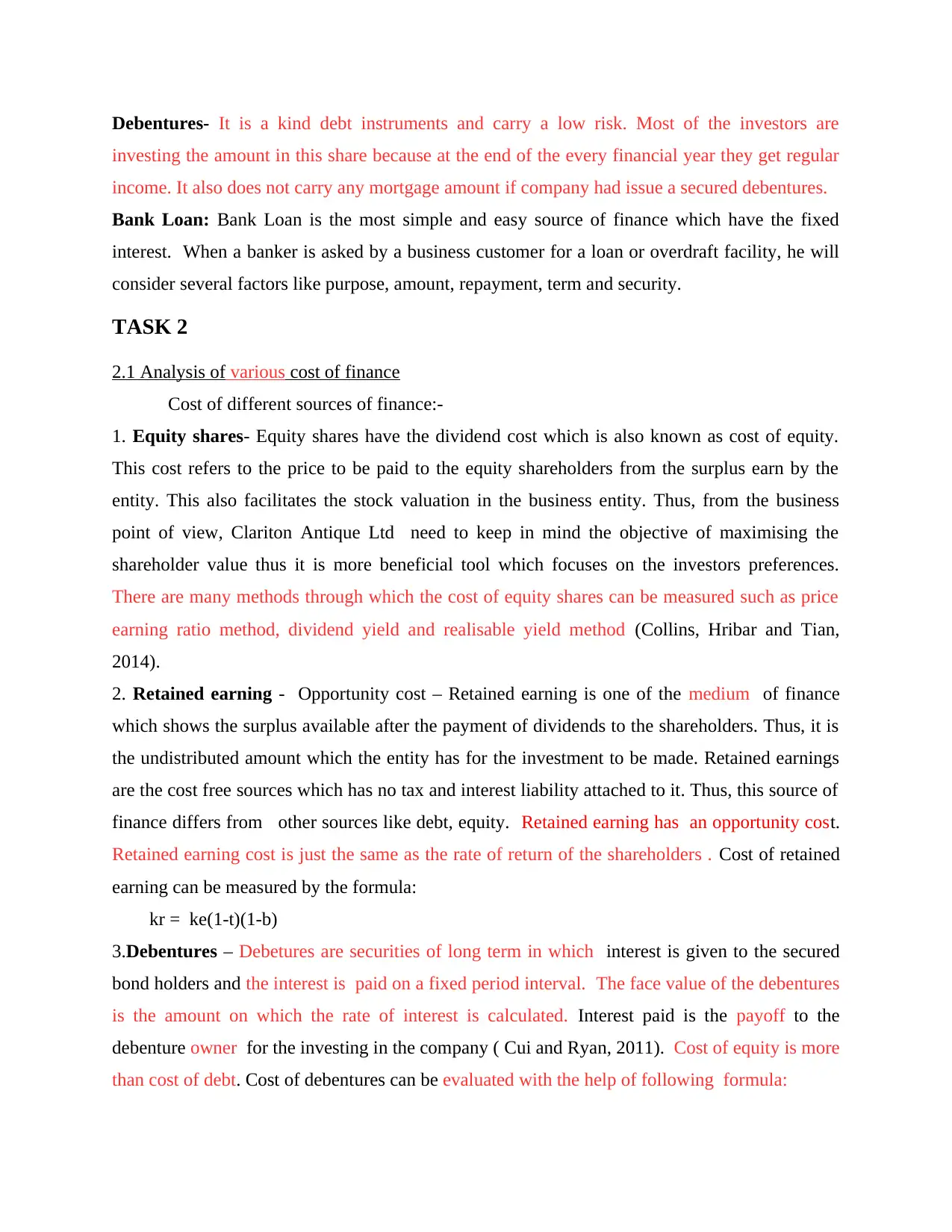
Debentures- It is a kind debt instruments and carry a low risk. Most of the investors are
investing the amount in this share because at the end of the every financial year they get regular
income. It also does not carry any mortgage amount if company had issue a secured debentures.
Bank Loan: Bank Loan is the most simple and easy source of finance which have the fixed
interest. When a banker is asked by a business customer for a loan or overdraft facility, he will
consider several factors like purpose, amount, repayment, term and security.
TASK 2
2.1 Analysis of various cost of finance
Cost of different sources of finance:-
1. Equity shares- Equity shares have the dividend cost which is also known as cost of equity.
This cost refers to the price to be paid to the equity shareholders from the surplus earn by the
entity. This also facilitates the stock valuation in the business entity. Thus, from the business
point of view, Clariton Antique Ltd need to keep in mind the objective of maximising the
shareholder value thus it is more beneficial tool which focuses on the investors preferences.
There are many methods through which the cost of equity shares can be measured such as price
earning ratio method, dividend yield and realisable yield method (Collins, Hribar and Tian,
2014).
2. Retained earning - Opportunity cost – Retained earning is one of the medium of finance
which shows the surplus available after the payment of dividends to the shareholders. Thus, it is
the undistributed amount which the entity has for the investment to be made. Retained earnings
are the cost free sources which has no tax and interest liability attached to it. Thus, this source of
finance differs from other sources like debt, equity. Retained earning has an opportunity cost.
Retained earning cost is just the same as the rate of return of the shareholders . Cost of retained
earning can be measured by the formula:
kr = ke(1-t)(1-b)
3.Debentures – Debetures are securities of long term in which interest is given to the secured
bond holders and the interest is paid on a fixed period interval. The face value of the debentures
is the amount on which the rate of interest is calculated. Interest paid is the payoff to the
debenture owner for the investing in the company ( Cui and Ryan, 2011). Cost of equity is more
than cost of debt. Cost of debentures can be evaluated with the help of following formula:
investing the amount in this share because at the end of the every financial year they get regular
income. It also does not carry any mortgage amount if company had issue a secured debentures.
Bank Loan: Bank Loan is the most simple and easy source of finance which have the fixed
interest. When a banker is asked by a business customer for a loan or overdraft facility, he will
consider several factors like purpose, amount, repayment, term and security.
TASK 2
2.1 Analysis of various cost of finance
Cost of different sources of finance:-
1. Equity shares- Equity shares have the dividend cost which is also known as cost of equity.
This cost refers to the price to be paid to the equity shareholders from the surplus earn by the
entity. This also facilitates the stock valuation in the business entity. Thus, from the business
point of view, Clariton Antique Ltd need to keep in mind the objective of maximising the
shareholder value thus it is more beneficial tool which focuses on the investors preferences.
There are many methods through which the cost of equity shares can be measured such as price
earning ratio method, dividend yield and realisable yield method (Collins, Hribar and Tian,
2014).
2. Retained earning - Opportunity cost – Retained earning is one of the medium of finance
which shows the surplus available after the payment of dividends to the shareholders. Thus, it is
the undistributed amount which the entity has for the investment to be made. Retained earnings
are the cost free sources which has no tax and interest liability attached to it. Thus, this source of
finance differs from other sources like debt, equity. Retained earning has an opportunity cost.
Retained earning cost is just the same as the rate of return of the shareholders . Cost of retained
earning can be measured by the formula:
kr = ke(1-t)(1-b)
3.Debentures – Debetures are securities of long term in which interest is given to the secured
bond holders and the interest is paid on a fixed period interval. The face value of the debentures
is the amount on which the rate of interest is calculated. Interest paid is the payoff to the
debenture owner for the investing in the company ( Cui and Ryan, 2011). Cost of equity is more
than cost of debt. Cost of debentures can be evaluated with the help of following formula:
⊘ This is a preview!⊘
Do you want full access?
Subscribe today to unlock all pages.

Trusted by 1+ million students worldwide
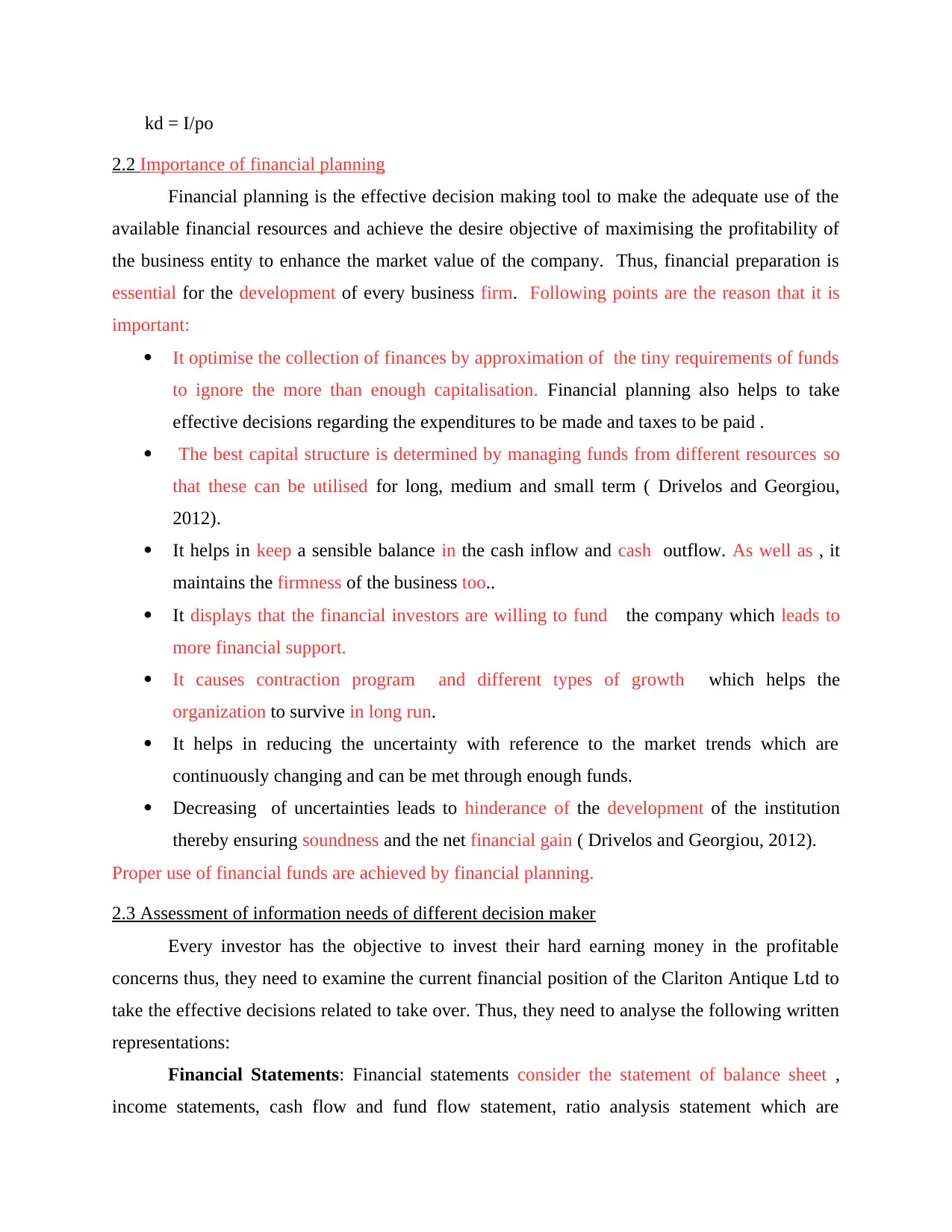
kd = I/po
2.2 Importance of financial planning
Financial planning is the effective decision making tool to make the adequate use of the
available financial resources and achieve the desire objective of maximising the profitability of
the business entity to enhance the market value of the company. Thus, financial preparation is
essential for the development of every business firm. Following points are the reason that it is
important:
It optimise the collection of finances by approximation of the tiny requirements of funds
to ignore the more than enough capitalisation. Financial planning also helps to take
effective decisions regarding the expenditures to be made and taxes to be paid .
The best capital structure is determined by managing funds from different resources so
that these can be utilised for long, medium and small term ( Drivelos and Georgiou,
2012).
It helps in keep a sensible balance in the cash inflow and cash outflow. As well as , it
maintains the firmness of the business too..
It displays that the financial investors are willing to fund the company which leads to
more financial support.
It causes contraction program and different types of growth which helps the
organization to survive in long run.
It helps in reducing the uncertainty with reference to the market trends which are
continuously changing and can be met through enough funds.
Decreasing of uncertainties leads to hinderance of the development of the institution
thereby ensuring soundness and the net financial gain ( Drivelos and Georgiou, 2012).
Proper use of financial funds are achieved by financial planning.
2.3 Assessment of information needs of different decision maker
Every investor has the objective to invest their hard earning money in the profitable
concerns thus, they need to examine the current financial position of the Clariton Antique Ltd to
take the effective decisions related to take over. Thus, they need to analyse the following written
representations:
Financial Statements: Financial statements consider the statement of balance sheet ,
income statements, cash flow and fund flow statement, ratio analysis statement which are
2.2 Importance of financial planning
Financial planning is the effective decision making tool to make the adequate use of the
available financial resources and achieve the desire objective of maximising the profitability of
the business entity to enhance the market value of the company. Thus, financial preparation is
essential for the development of every business firm. Following points are the reason that it is
important:
It optimise the collection of finances by approximation of the tiny requirements of funds
to ignore the more than enough capitalisation. Financial planning also helps to take
effective decisions regarding the expenditures to be made and taxes to be paid .
The best capital structure is determined by managing funds from different resources so
that these can be utilised for long, medium and small term ( Drivelos and Georgiou,
2012).
It helps in keep a sensible balance in the cash inflow and cash outflow. As well as , it
maintains the firmness of the business too..
It displays that the financial investors are willing to fund the company which leads to
more financial support.
It causes contraction program and different types of growth which helps the
organization to survive in long run.
It helps in reducing the uncertainty with reference to the market trends which are
continuously changing and can be met through enough funds.
Decreasing of uncertainties leads to hinderance of the development of the institution
thereby ensuring soundness and the net financial gain ( Drivelos and Georgiou, 2012).
Proper use of financial funds are achieved by financial planning.
2.3 Assessment of information needs of different decision maker
Every investor has the objective to invest their hard earning money in the profitable
concerns thus, they need to examine the current financial position of the Clariton Antique Ltd to
take the effective decisions related to take over. Thus, they need to analyse the following written
representations:
Financial Statements: Financial statements consider the statement of balance sheet ,
income statements, cash flow and fund flow statement, ratio analysis statement which are
Paraphrase This Document
Need a fresh take? Get an instant paraphrase of this document with our AI Paraphraser
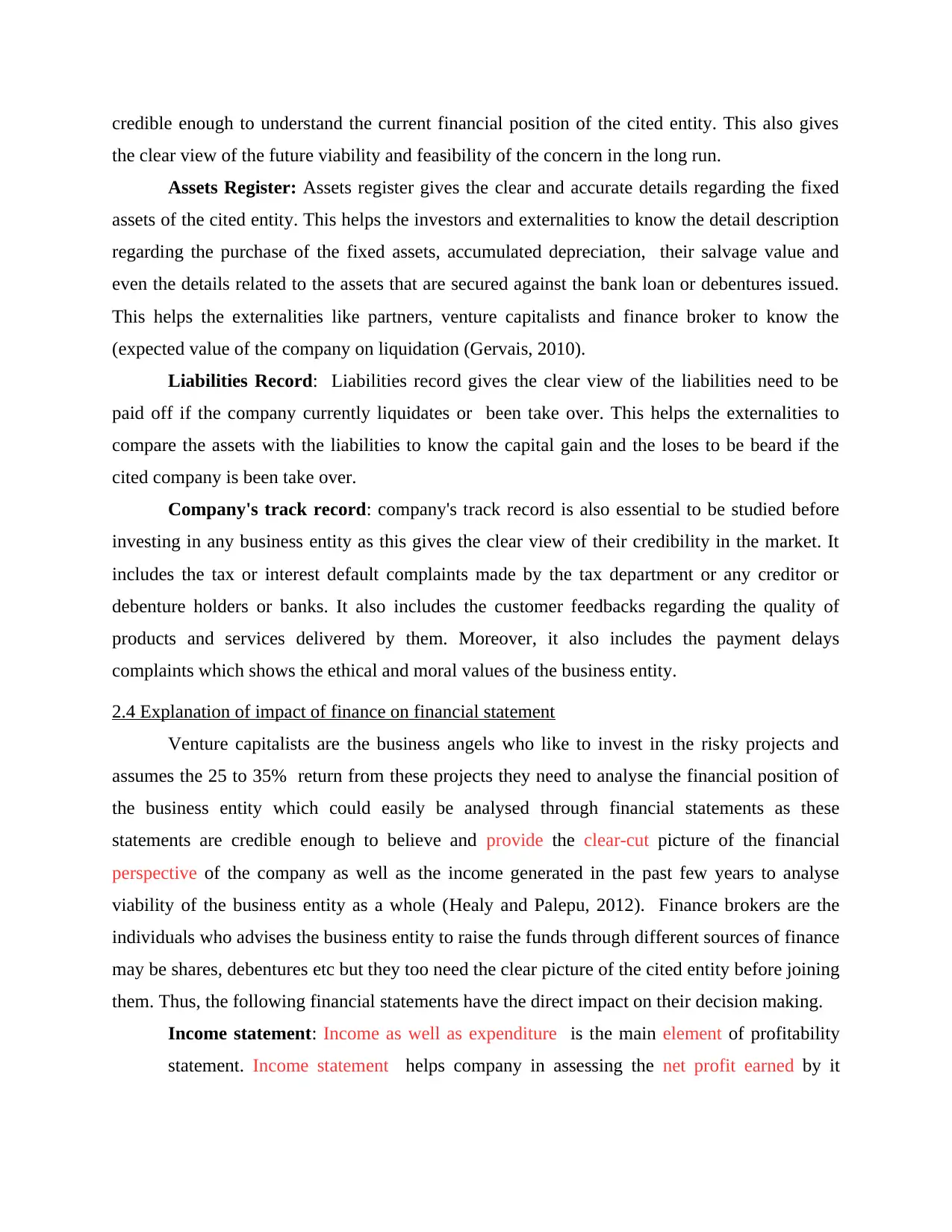
credible enough to understand the current financial position of the cited entity. This also gives
the clear view of the future viability and feasibility of the concern in the long run.
Assets Register: Assets register gives the clear and accurate details regarding the fixed
assets of the cited entity. This helps the investors and externalities to know the detail description
regarding the purchase of the fixed assets, accumulated depreciation, their salvage value and
even the details related to the assets that are secured against the bank loan or debentures issued.
This helps the externalities like partners, venture capitalists and finance broker to know the
(expected value of the company on liquidation (Gervais, 2010).
Liabilities Record: Liabilities record gives the clear view of the liabilities need to be
paid off if the company currently liquidates or been take over. This helps the externalities to
compare the assets with the liabilities to know the capital gain and the loses to be beard if the
cited company is been take over.
Company's track record: company's track record is also essential to be studied before
investing in any business entity as this gives the clear view of their credibility in the market. It
includes the tax or interest default complaints made by the tax department or any creditor or
debenture holders or banks. It also includes the customer feedbacks regarding the quality of
products and services delivered by them. Moreover, it also includes the payment delays
complaints which shows the ethical and moral values of the business entity.
2.4 Explanation of impact of finance on financial statement
Venture capitalists are the business angels who like to invest in the risky projects and
assumes the 25 to 35% return from these projects they need to analyse the financial position of
the business entity which could easily be analysed through financial statements as these
statements are credible enough to believe and provide the clear-cut picture of the financial
perspective of the company as well as the income generated in the past few years to analyse
viability of the business entity as a whole (Healy and Palepu, 2012). Finance brokers are the
individuals who advises the business entity to raise the funds through different sources of finance
may be shares, debentures etc but they too need the clear picture of the cited entity before joining
them. Thus, the following financial statements have the direct impact on their decision making.
Income statement: Income as well as expenditure is the main element of profitability
statement. Income statement helps company in assessing the net profit earned by it
the clear view of the future viability and feasibility of the concern in the long run.
Assets Register: Assets register gives the clear and accurate details regarding the fixed
assets of the cited entity. This helps the investors and externalities to know the detail description
regarding the purchase of the fixed assets, accumulated depreciation, their salvage value and
even the details related to the assets that are secured against the bank loan or debentures issued.
This helps the externalities like partners, venture capitalists and finance broker to know the
(expected value of the company on liquidation (Gervais, 2010).
Liabilities Record: Liabilities record gives the clear view of the liabilities need to be
paid off if the company currently liquidates or been take over. This helps the externalities to
compare the assets with the liabilities to know the capital gain and the loses to be beard if the
cited company is been take over.
Company's track record: company's track record is also essential to be studied before
investing in any business entity as this gives the clear view of their credibility in the market. It
includes the tax or interest default complaints made by the tax department or any creditor or
debenture holders or banks. It also includes the customer feedbacks regarding the quality of
products and services delivered by them. Moreover, it also includes the payment delays
complaints which shows the ethical and moral values of the business entity.
2.4 Explanation of impact of finance on financial statement
Venture capitalists are the business angels who like to invest in the risky projects and
assumes the 25 to 35% return from these projects they need to analyse the financial position of
the business entity which could easily be analysed through financial statements as these
statements are credible enough to believe and provide the clear-cut picture of the financial
perspective of the company as well as the income generated in the past few years to analyse
viability of the business entity as a whole (Healy and Palepu, 2012). Finance brokers are the
individuals who advises the business entity to raise the funds through different sources of finance
may be shares, debentures etc but they too need the clear picture of the cited entity before joining
them. Thus, the following financial statements have the direct impact on their decision making.
Income statement: Income as well as expenditure is the main element of profitability
statement. Income statement helps company in assessing the net profit earned by it
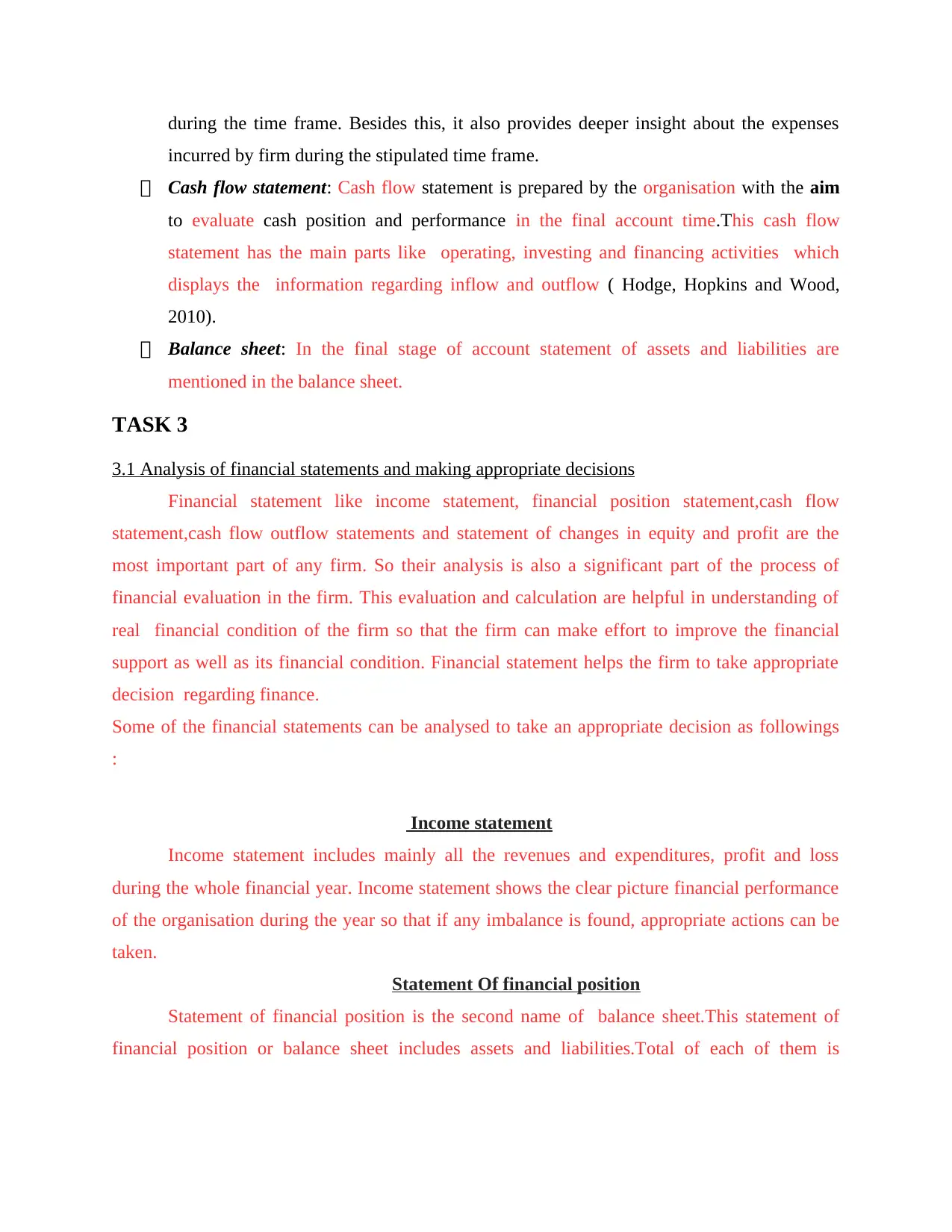
during the time frame. Besides this, it also provides deeper insight about the expenses
incurred by firm during the stipulated time frame.
Cash flow statement: Cash flow statement is prepared by the organisation with the aim
to evaluate cash position and performance in the final account time.This cash flow
statement has the main parts like operating, investing and financing activities which
displays the information regarding inflow and outflow ( Hodge, Hopkins and Wood,
2010).
Balance sheet: In the final stage of account statement of assets and liabilities are
mentioned in the balance sheet.
TASK 3
3.1 Analysis of financial statements and making appropriate decisions
Financial statement like income statement, financial position statement,cash flow
statement,cash flow outflow statements and statement of changes in equity and profit are the
most important part of any firm. So their analysis is also a significant part of the process of
financial evaluation in the firm. This evaluation and calculation are helpful in understanding of
real financial condition of the firm so that the firm can make effort to improve the financial
support as well as its financial condition. Financial statement helps the firm to take appropriate
decision regarding finance.
Some of the financial statements can be analysed to take an appropriate decision as followings
:
Income statement
Income statement includes mainly all the revenues and expenditures, profit and loss
during the whole financial year. Income statement shows the clear picture financial performance
of the organisation during the year so that if any imbalance is found, appropriate actions can be
taken.
Statement Of financial position
Statement of financial position is the second name of balance sheet.This statement of
financial position or balance sheet includes assets and liabilities.Total of each of them is
incurred by firm during the stipulated time frame.
Cash flow statement: Cash flow statement is prepared by the organisation with the aim
to evaluate cash position and performance in the final account time.This cash flow
statement has the main parts like operating, investing and financing activities which
displays the information regarding inflow and outflow ( Hodge, Hopkins and Wood,
2010).
Balance sheet: In the final stage of account statement of assets and liabilities are
mentioned in the balance sheet.
TASK 3
3.1 Analysis of financial statements and making appropriate decisions
Financial statement like income statement, financial position statement,cash flow
statement,cash flow outflow statements and statement of changes in equity and profit are the
most important part of any firm. So their analysis is also a significant part of the process of
financial evaluation in the firm. This evaluation and calculation are helpful in understanding of
real financial condition of the firm so that the firm can make effort to improve the financial
support as well as its financial condition. Financial statement helps the firm to take appropriate
decision regarding finance.
Some of the financial statements can be analysed to take an appropriate decision as followings
:
Income statement
Income statement includes mainly all the revenues and expenditures, profit and loss
during the whole financial year. Income statement shows the clear picture financial performance
of the organisation during the year so that if any imbalance is found, appropriate actions can be
taken.
Statement Of financial position
Statement of financial position is the second name of balance sheet.This statement of
financial position or balance sheet includes assets and liabilities.Total of each of them is
⊘ This is a preview!⊘
Do you want full access?
Subscribe today to unlock all pages.

Trusted by 1+ million students worldwide
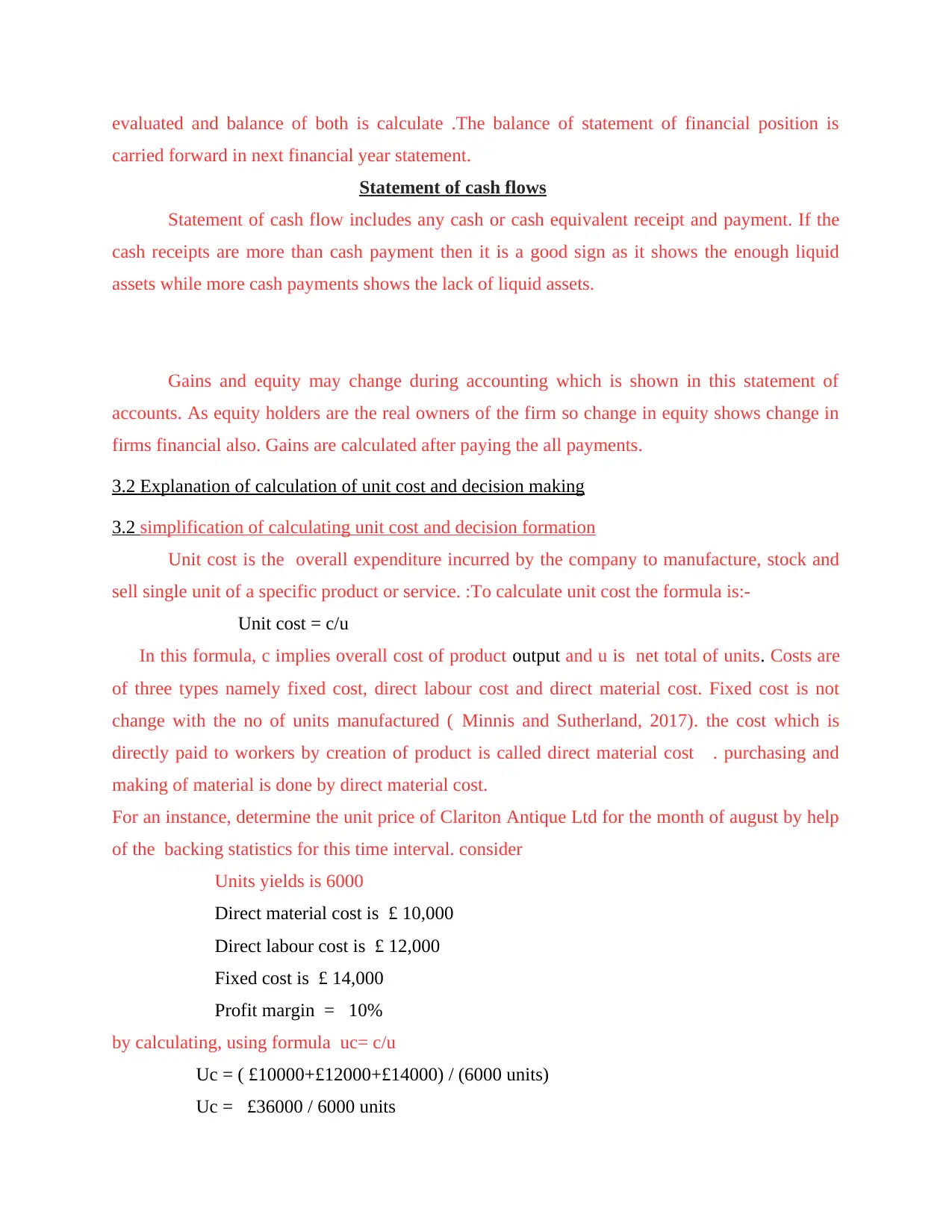
evaluated and balance of both is calculate .The balance of statement of financial position is
carried forward in next financial year statement.
Statement of cash flows
Statement of cash flow includes any cash or cash equivalent receipt and payment. If the
cash receipts are more than cash payment then it is a good sign as it shows the enough liquid
assets while more cash payments shows the lack of liquid assets.
Gains and equity may change during accounting which is shown in this statement of
accounts. As equity holders are the real owners of the firm so change in equity shows change in
firms financial also. Gains are calculated after paying the all payments.
3.2 Explanation of calculation of unit cost and decision making
3.2 simplification of calculating unit cost and decision formation
Unit cost is the overall expenditure incurred by the company to manufacture, stock and
sell single unit of a specific product or service. :To calculate unit cost the formula is:-
Unit cost = c/u
In this formula, c implies overall cost of product output and u is net total of units. Costs are
of three types namely fixed cost, direct labour cost and direct material cost. Fixed cost is not
change with the no of units manufactured ( Minnis and Sutherland, 2017). the cost which is
directly paid to workers by creation of product is called direct material cost . purchasing and
making of material is done by direct material cost.
For an instance, determine the unit price of Clariton Antique Ltd for the month of august by help
of the backing statistics for this time interval. consider
Units yields is 6000
Direct material cost is £ 10,000
Direct labour cost is £ 12,000
Fixed cost is £ 14,000
Profit margin = 10%
by calculating, using formula uc= c/u
Uc = ( £10000+£12000+£14000) / (6000 units)
Uc = £36000 / 6000 units
carried forward in next financial year statement.
Statement of cash flows
Statement of cash flow includes any cash or cash equivalent receipt and payment. If the
cash receipts are more than cash payment then it is a good sign as it shows the enough liquid
assets while more cash payments shows the lack of liquid assets.
Gains and equity may change during accounting which is shown in this statement of
accounts. As equity holders are the real owners of the firm so change in equity shows change in
firms financial also. Gains are calculated after paying the all payments.
3.2 Explanation of calculation of unit cost and decision making
3.2 simplification of calculating unit cost and decision formation
Unit cost is the overall expenditure incurred by the company to manufacture, stock and
sell single unit of a specific product or service. :To calculate unit cost the formula is:-
Unit cost = c/u
In this formula, c implies overall cost of product output and u is net total of units. Costs are
of three types namely fixed cost, direct labour cost and direct material cost. Fixed cost is not
change with the no of units manufactured ( Minnis and Sutherland, 2017). the cost which is
directly paid to workers by creation of product is called direct material cost . purchasing and
making of material is done by direct material cost.
For an instance, determine the unit price of Clariton Antique Ltd for the month of august by help
of the backing statistics for this time interval. consider
Units yields is 6000
Direct material cost is £ 10,000
Direct labour cost is £ 12,000
Fixed cost is £ 14,000
Profit margin = 10%
by calculating, using formula uc= c/u
Uc = ( £10000+£12000+£14000) / (6000 units)
Uc = £36000 / 6000 units
Paraphrase This Document
Need a fresh take? Get an instant paraphrase of this document with our AI Paraphraser
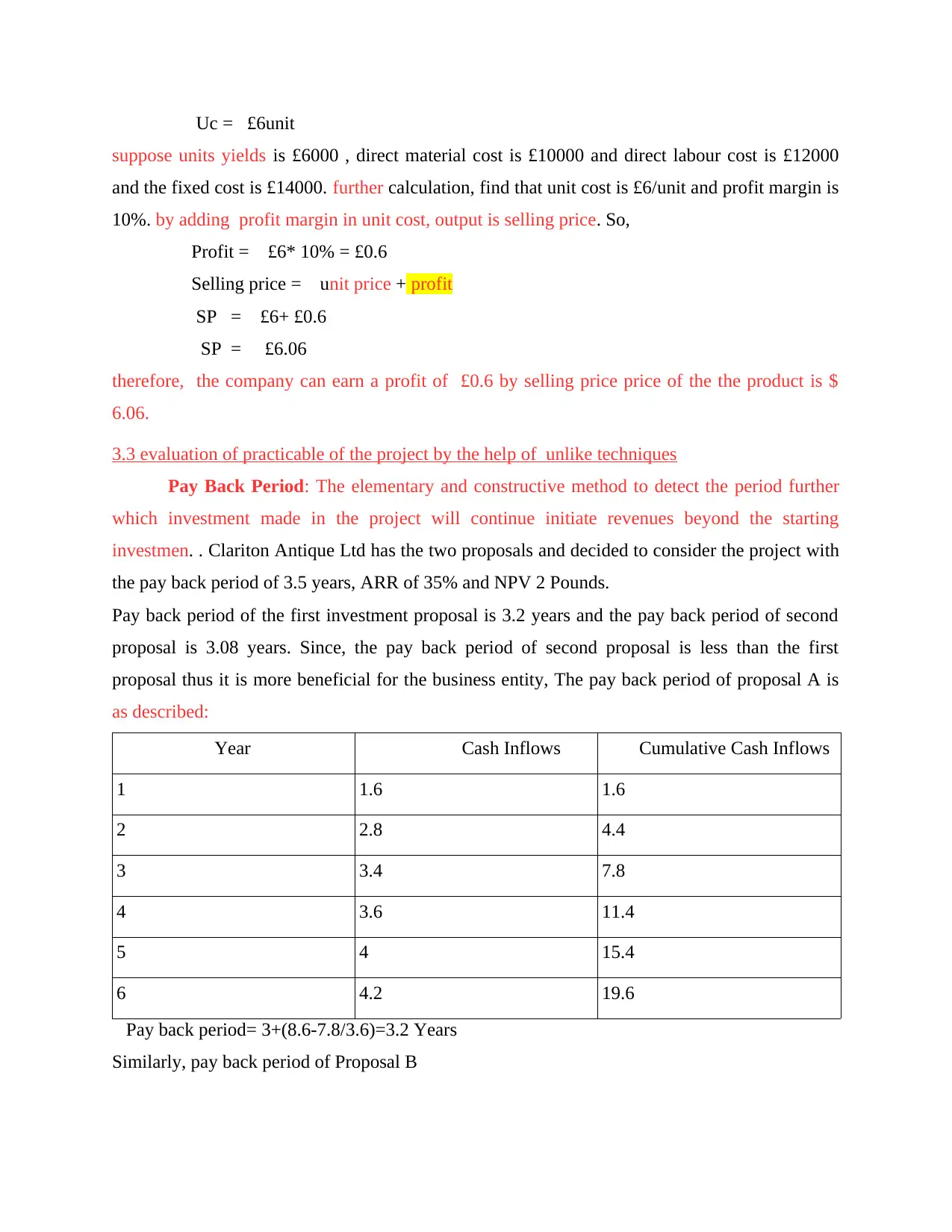
Uc = £6unit
suppose units yields is £6000 , direct material cost is £10000 and direct labour cost is £12000
and the fixed cost is £14000. further calculation, find that unit cost is £6/unit and profit margin is
10%. by adding profit margin in unit cost, output is selling price. So,
Profit = £6* 10% = £0.6
Selling price = unit price + profit
SP = £6+ £0.6
SP = £6.06
therefore, the company can earn a profit of £0.6 by selling price price of the the product is $
6.06.
3.3 evaluation of practicable of the project by the help of unlike techniques
Pay Back Period: The elementary and constructive method to detect the period further
which investment made in the project will continue initiate revenues beyond the starting
investmen. . Clariton Antique Ltd has the two proposals and decided to consider the project with
the pay back period of 3.5 years, ARR of 35% and NPV 2 Pounds.
Pay back period of the first investment proposal is 3.2 years and the pay back period of second
proposal is 3.08 years. Since, the pay back period of second proposal is less than the first
proposal thus it is more beneficial for the business entity, The pay back period of proposal A is
as described:
Year Cash Inflows Cumulative Cash Inflows
1 1.6 1.6
2 2.8 4.4
3 3.4 7.8
4 3.6 11.4
5 4 15.4
6 4.2 19.6
Pay back period= 3+(8.6-7.8/3.6)=3.2 Years
Similarly, pay back period of Proposal B
suppose units yields is £6000 , direct material cost is £10000 and direct labour cost is £12000
and the fixed cost is £14000. further calculation, find that unit cost is £6/unit and profit margin is
10%. by adding profit margin in unit cost, output is selling price. So,
Profit = £6* 10% = £0.6
Selling price = unit price + profit
SP = £6+ £0.6
SP = £6.06
therefore, the company can earn a profit of £0.6 by selling price price of the the product is $
6.06.
3.3 evaluation of practicable of the project by the help of unlike techniques
Pay Back Period: The elementary and constructive method to detect the period further
which investment made in the project will continue initiate revenues beyond the starting
investmen. . Clariton Antique Ltd has the two proposals and decided to consider the project with
the pay back period of 3.5 years, ARR of 35% and NPV 2 Pounds.
Pay back period of the first investment proposal is 3.2 years and the pay back period of second
proposal is 3.08 years. Since, the pay back period of second proposal is less than the first
proposal thus it is more beneficial for the business entity, The pay back period of proposal A is
as described:
Year Cash Inflows Cumulative Cash Inflows
1 1.6 1.6
2 2.8 4.4
3 3.4 7.8
4 3.6 11.4
5 4 15.4
6 4.2 19.6
Pay back period= 3+(8.6-7.8/3.6)=3.2 Years
Similarly, pay back period of Proposal B
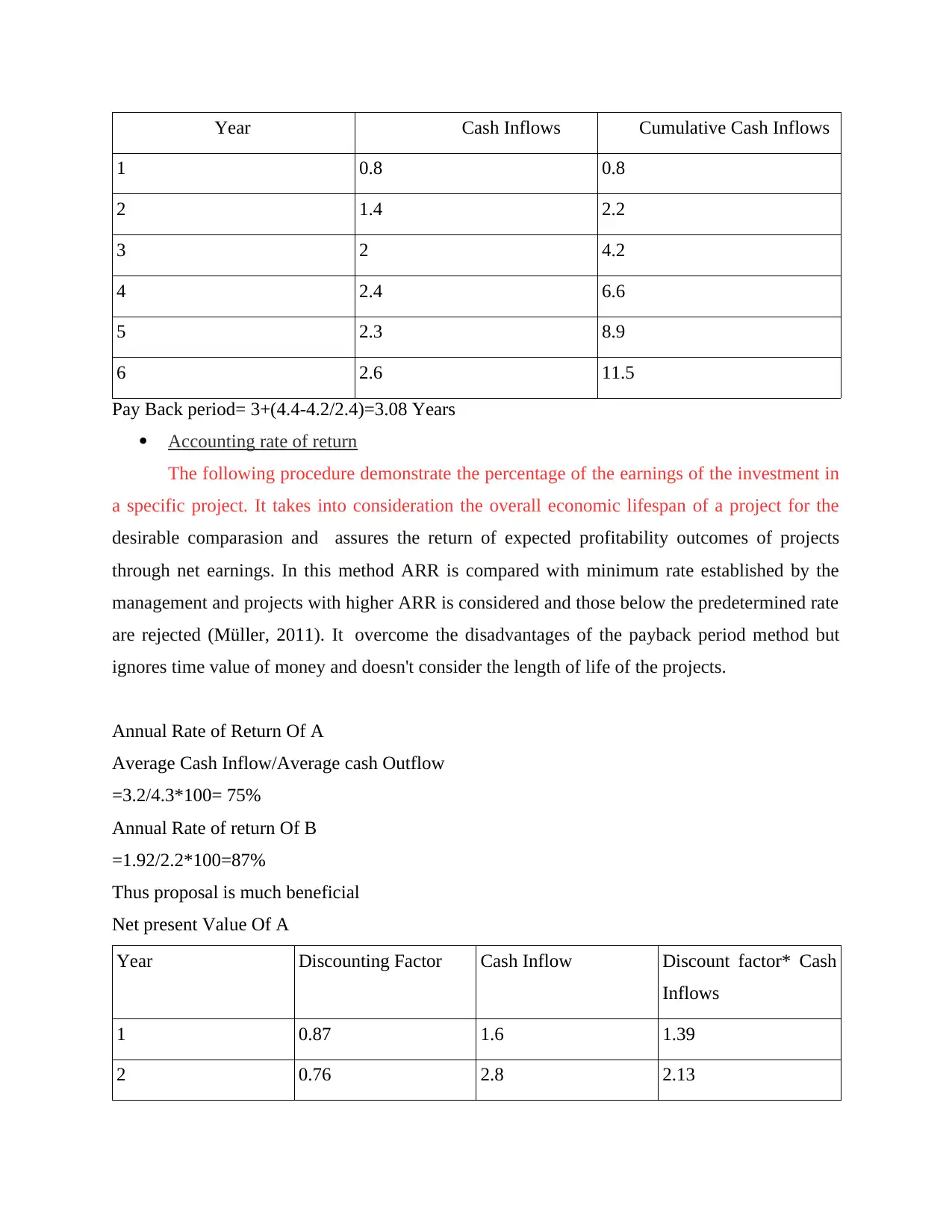
Year Cash Inflows Cumulative Cash Inflows
1 0.8 0.8
2 1.4 2.2
3 2 4.2
4 2.4 6.6
5 2.3 8.9
6 2.6 11.5
Pay Back period= 3+(4.4-4.2/2.4)=3.08 Years
Accounting rate of return
The following procedure demonstrate the percentage of the earnings of the investment in
a specific project. It takes into consideration the overall economic lifespan of a project for the
desirable comparasion and assures the return of expected profitability outcomes of projects
through net earnings. In this method ARR is compared with minimum rate established by the
management and projects with higher ARR is considered and those below the predetermined rate
are rejected (Müller, 2011). It overcome the disadvantages of the payback period method but
ignores time value of money and doesn't consider the length of life of the projects.
Annual Rate of Return Of A
Average Cash Inflow/Average cash Outflow
=3.2/4.3*100= 75%
Annual Rate of return Of B
=1.92/2.2*100=87%
Thus proposal is much beneficial
Net present Value Of A
Year Discounting Factor Cash Inflow Discount factor* Cash
Inflows
1 0.87 1.6 1.39
2 0.76 2.8 2.13
1 0.8 0.8
2 1.4 2.2
3 2 4.2
4 2.4 6.6
5 2.3 8.9
6 2.6 11.5
Pay Back period= 3+(4.4-4.2/2.4)=3.08 Years
Accounting rate of return
The following procedure demonstrate the percentage of the earnings of the investment in
a specific project. It takes into consideration the overall economic lifespan of a project for the
desirable comparasion and assures the return of expected profitability outcomes of projects
through net earnings. In this method ARR is compared with minimum rate established by the
management and projects with higher ARR is considered and those below the predetermined rate
are rejected (Müller, 2011). It overcome the disadvantages of the payback period method but
ignores time value of money and doesn't consider the length of life of the projects.
Annual Rate of Return Of A
Average Cash Inflow/Average cash Outflow
=3.2/4.3*100= 75%
Annual Rate of return Of B
=1.92/2.2*100=87%
Thus proposal is much beneficial
Net present Value Of A
Year Discounting Factor Cash Inflow Discount factor* Cash
Inflows
1 0.87 1.6 1.39
2 0.76 2.8 2.13
⊘ This is a preview!⊘
Do you want full access?
Subscribe today to unlock all pages.

Trusted by 1+ million students worldwide
1 out of 21
Related Documents
Your All-in-One AI-Powered Toolkit for Academic Success.
+13062052269
info@desklib.com
Available 24*7 on WhatsApp / Email
![[object Object]](/_next/static/media/star-bottom.7253800d.svg)
Unlock your academic potential
Copyright © 2020–2025 A2Z Services. All Rights Reserved. Developed and managed by ZUCOL.




